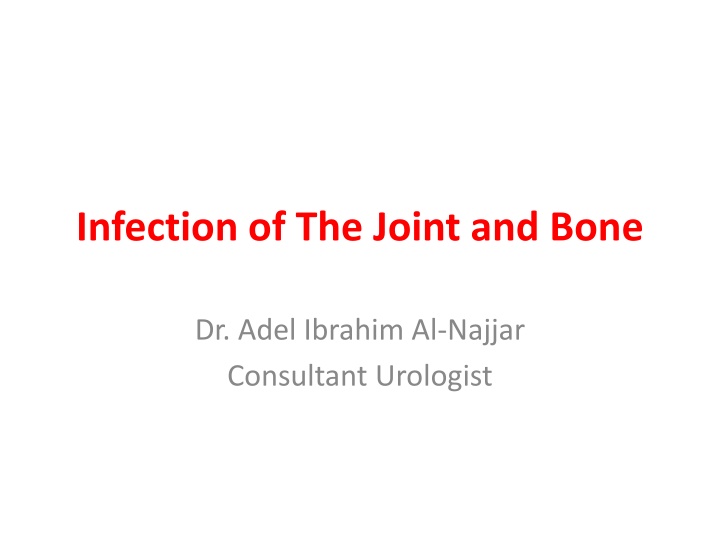
Osteomyelitis: Causes, Symptoms, and Treatment
Learn about osteomyelitis, a bone and joint infection caused by bacteria or other germs. Discover the causes, risk factors, symptoms, exams and tests, and treatment options including antibiotics and surgery.
Download Presentation

Please find below an Image/Link to download the presentation.
The content on the website is provided AS IS for your information and personal use only. It may not be sold, licensed, or shared on other websites without obtaining consent from the author. If you encounter any issues during the download, it is possible that the publisher has removed the file from their server.
You are allowed to download the files provided on this website for personal or commercial use, subject to the condition that they are used lawfully. All files are the property of their respective owners.
The content on the website is provided AS IS for your information and personal use only. It may not be sold, licensed, or shared on other websites without obtaining consent from the author.
E N D
Presentation Transcript
Infection of The Joint and Bone Dr. Adel Ibrahim Al-Najjar Consultant Urologist
Definition Osteomyelitis is a bone and joint infection. It is mainly caused by bacteria or other germs
Causes Bone infection is most often caused by bacteria. But it can also be caused by fungi or other germs. When a person has osteomyelitis: Bacteria or other germs may spread to a bone from infected skin, muscles, or tendons next to the bone. This may occur under a skin sore. The infection can start in another part of the body and spread to the bone through the blood. The infection can also start after bone surgery. This is more likely if the surgery is done after an injury or if metal rods or plates are placed in the bone
Risk factors are: Diabetes Hemodialysis Poor blood supply Recent injury Use of injected illicit drugs Surgery involving bones Weakened immune system
Symptoms Bone and joint pain Excessive sweating Fever and chills General discomfort, uneasiness, or ill feeling (malaise) Local swelling, redness, and warmth Open wound that may show pus Pain at the site of infection
Exams and Tests Blood cultures Bone biopsy (the sample is cultured and examined under a microscope) Bone scan Bone x-ray Complete blood count (CBC) C-reactive protein (CRP) Erythrocyte sedimentation rate (ESR) MRI of the bone Needle aspiration of the area of the affected bones
Treatment The goal of treatment is to get rid of the infection and reduce damage to the bone and surrounding tissues. Antibiotics are given to destroy the bacteria causing the infection: You may receive more than one antibiotic at a time. Antibiotics are taken for at least 4 to 6 weeks, often at home through an IV (intravenously, meaning through a vein).
Surgery may be needed to remove dead bone tissue if the above methods fail: If there are metal plates near the infection, they may need to be removed. The open space left by the removed bone tissue may be filled with bone graft or packing material. This promotes resolution of the infection.
If you have diabetes, it will need to be well controlled. If there are problems with blood supply to the infected area, such as the foot, surgery may be needed to improve blood flow in order to get rid of the infection.
Bone and joint infections are usually caused by bacteria called Staphylococcus aureus (or staph ) and require treatment with antibiotics. A serious form of staph known as methicillin-resistant Staphylococcus aureus (MRSA) causes infections that can be more severe and need special antibiotics to treat. It is important to recognize and treat bone and joint infections because they can: Spread to the blood and other organs causing life-threatening illness Damage growth plates, bones and joints Cause chronic arthritis and bone fractures






















